Challenges regarding social media platforms
One of the common challenges that PV professionals face is the validity and authenticity of the AE posted on a particular social media platform. Who reported the AE? Did they report it in real time? How accurate is their analysis? Furthermore, the possibility of the AE post on social media being seen by a large volume of users is far greater; such misinformation could cause fear among other patients using the same drug and lead to them prematurely discontinue the treatment. Additionally, as AE reporting on social media is far more straightforward and convenient than reporting spontaneous AEs through traditional means, the volume of AE reports is relatively larger which burdens pharmaceutical organizations, MAHs, and PV professionals that must review the data for potentially serious and rare AEs. Finally, traceability to the reporter is limited through social media platforms compared to traditional reporting systems that mandate information on the AE, the drug, the reporter, and their contact details [2]. Hence, AE reports from social media platforms could create obstacles particularly given the rapidly changing regulatory environment. While social and digital media AE reports add to the volume of safety information available for post-market surveillance, the debate on their authenticity still remains and is foreseen as an ongoing challenge in drug safety.
Support from Regulatory Authorities
- How manufacturers, distributors etc can fulfil regulatory requirements for post-marketing submissions in the promotional content posted on social media [3];
- How pharmaceutical organizations can tackle problems related to space & character limitations [4];
- How companies can proactively and compliantly correct misinformation communicated by third-party social media vendors regarding their products [5].
Pharmacovigilance support with DDReg
References and further reading:
[1] Fox S, Duggan M. Health online 2013. Health. 2013;2013:1–55
[2] Naik, Paulami, et al. “Regulatory definitions and good pharmacovigilance practices in social media: challenges and recommendations.” Therapeutic Innovation & Regulatory Science 49.6 (2015): 840-851.
[3] United States Food and Drug Administration. Fulfilling Regulatory Requirements for Postmarketing Submissions of Interactive Promotional Media for Prescription Human and Animal Drugs and Biologics. January 2014. Accessed January 2023.
[4] United States Food and Drug Administration- Federal Register. Internet/Social Media Platforms with Character Space Limitations: Presenting Risk and Benefit Information for Prescription Drugs and Medical Devices. September 2014. Accessed January 2023.
[5] United States Food and Drug Administration. Internet/Social Media Platforms: Correcting Independent Third-Party Misinformation about Prescription Drugs and Medical Devices. June 2014. Accessed January 2023.

